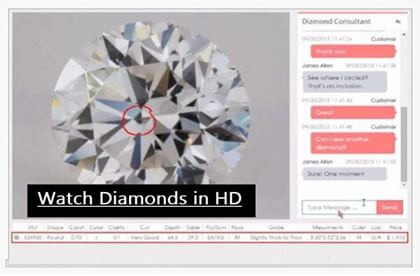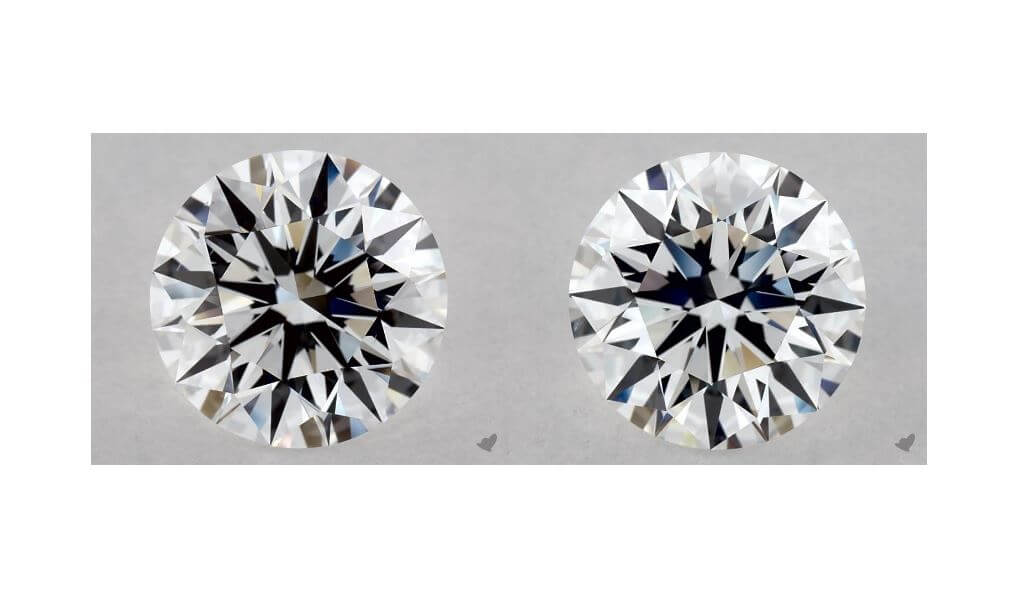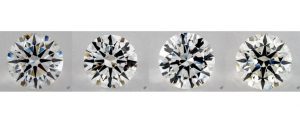Executive Summary
Moissanite and lab-grown diamonds offer a lot of similarities with natural diamonds. Lab grown diamonds are synthesized from carbon in the lab. Moissanite are from the compound silicon carbide and are also synthesized in the laboratory. The fact that these two diamond alternatives are both synthesized in the lab makes them viable alternatives to natural diamonds. They do not require mining. This implies that they do not create mineral waste or disturb the natural order of the earth. This makes them a more environmental and eco-friendly choice for diamond buyers.
These alternatives are also much cheaper than natural diamonds. Although lab grown diamonds and natural diamonds are valued with the same factors of shape, cut, color, clarity and carat weight, they are still very much cheaper. Moissanite are valued only based on size and whether the stone is premium. This makes them a good choice for couples that are conscious of price but want a ‘diamond’ engagement ring.
Lab grown diamond and moissanite also offer a lot of similarities to natural diamonds. Lab grown diamond have the same rating with natural diamond on the Mohr’s scale while moissanite has a rating 0.75 lesser than natural diamonds. This means that they are very durable, exactly like natural diamonds.

Moissanite vs Lab Grown Diamond Which One is best?
Moissanite and lab diamonds are both very good alternatives to the naturally mined diamonds. These two diamond alternatives have a lot of similarities and also a lot of differences between them. It is important for diamond lovers and those settling for these alternatives to understand what moissanite and lab diamonds are, their differences and how to identify them.
Moissanite
Moissanite is made from silicon carbide. It is considered an alternative to diamond due to its durability, shimmering appearance, and the significantly lower price tag it carries.
Moissanite was discovered in 1893 by French scientist Henri Moissan while he was examining rock samples gotten from a meteor crater. He initially thought that these crystals were diamonds, especially considering the fact that the hardness of moissanite is very similar to that of a diamond. It wasn’t until 1904 that he realized that moissanite were not made from carbon but from silicon carbide. He was later awarded with a Nobel Peace Prize for being able to isolate fluorine from its compound. The mineral version of the silicon carbide was thereafter named after him.
Moissanite is created today by synthesis in the lab. This is because the mineral silicon carbide is an extremely rare mineral. There are very few environments where it has been found like the Green River Formation in Wyoming, in meteorites, and as inclusions in diamonds.
Benefits of moissanite
There are many individuals today who prefer moissanite as their choice of diamond alternative. This is because of the benefits which moissanite has.
Unarguably, the biggest benefit which moissanite has is its low cost. Moissanite is a great choice as a forever ring or an engagement ring for couples that are very conscious of cost. They are price basically based on their size and whether they are premium or super premium(Super premium has a less yellow color than the premium). For instance, a round 8mm moissanite, with a size of about 2 carats would cost less than $2,000.
Another benefit to moissanite is the level of hardness that it has. Moissanite is rated very high on the Mohr’s scale of hardness. It is just 0.75 below the hardness of a diamond (which is the hardest substance). This makes the moissanite a very durable gemstone and the preferred option for people that get involved in a lot of work that involves their hands and/or for those that don’t plan to remove their ring before carrying out some activities.
Lab-grown diamonds
Lab grown diamonds are another interesting alternative to naturally mined diamonds. These man-made diamonds are grown in the lab using advanced, cutting-edge technology. They have the same physical, chemical, and optical characteristics as the natural diamonds. These lab-grown diamonds are very identical to those that form naturally under the earth crust. The difference in both physically is where they were formed.
Benefits of lab-grown diamond
Apart from where they were formed, there are some distinctions between lab-grown diamonds and natural diamonds that many diamond lovers see as huge advantage.
Firstly, they are very sustainable. They are a sure way to ensure that we get diamonds that are 100% ethically sourced. Although, there are a lot of regulations that have been put into place to ensure that the adverse effects from the mining processes are curbed or reduced, it is almost impossible to say that a mined diamond was sourced ethically, and there’s no way to confirm it.
These lab-grown diamonds are also very environment friendly. Very much unlike the naturally mined diamonds that involves digging the earth crust and altering the natural order of the earth. For instance, according to a study, in order to mine out just 1 carat of diamond, almost 100 square feet of land is disturbed and there are about 6000 pounds of mineral waste created from this process. But on the other hand, creating 1 carat of a lab-grown diamond results in just 0.07 square feet of land being disturbed and the mineral waste created is just 1 pound.
Lastly, lab-grown diamonds are a lot less expensive than natural diamonds. They are about 20-40% less expensive than natural diamonds. Couples that are looking for a real diamond at a very affordable price can look towards this man-made diamond alternative.
Comparing Moissanite, Lab-Grown Diamond and a Natural Diamond
Durability: The hardness of a gemstone is measured on the Mohr’s scale of hardness. This assesses the ability of a gemstone to withstand scratching on a surface. Diamonds have a hardness of 10 and are known to be the hardest substance on earth. This exceptional rating on the Mohr’s scale means that diamonds are very durable and suitable for everyday use. This is one of the reasons why diamonds are a very popular gemstone for engagement rings. Lab-grown diamonds are very similar to natural diamonds in this regard and also have a rating of 10 on Mohr’s scale. Moissanite on the other hand has a rating of 9.25 on the Mohr’s scale. This is a very impressive score, and is one of the reasons why moissanite are considered a suitable alternative to diamonds.
Brilliance: The brilliance of a gem refers to the appearance of light that is reflected from inside the gem. One way to distinguish between a diamond and a moissanite is the brilliance of the gem. Diamonds respond to light in three different ways. The ability to reflect white light back is known as the diamond brilliance. That’s the first type of response to light. The refraction of light in diamond forms a rainbow color through dispersion. This is known as the fire of the diamond. The third response of diamond to light is the surface sparkle from a diamond. This is known as scintillation of the diamond. Combining these three responses of diamond to light gives the diamonds the sparkle they are famous for.
Moissanite shows a different kind of brilliance from the diamond’s brilliance. This is because the faceting pattern of moissanite is different from the ones of diamonds. Moissanite shows a fiery rainbow flash. Many people love this brilliance but there are some others that feel this heightened brilliance creates an effect known as “disco ball effect” especially when it is under sunlight. The refractive index of moissanite is from 2.65-2.69. This is higher than the one of diamond. The bigger the moissanite is, the more noticeable the difference in the brilliance with diamond is.
Color: This is the presence or absence of natural color within the gemstone. The natural color commonly seen in diamonds with color is yellow. Whether it is natural or lab-grown diamond, colorless diamonds usually lack this yellow or brownish tint. This increases the dazzling white appearance of the diamond.
Moissanite are mainly colorless but there are still some of the gem that may have some yellow or grayish hue under certain lights. The size of the moissanite goes a long way in determining how noticeable the color in it is. The bigger the gem, the more noticeable the color in it is (if there’s any).
Price: Natural diamonds are very expensive. This is first because of the process involved in mining them. They are valued based on other factors like shape, cut, color, clarity, and carat weight. Lab-grown diamonds on the other hand are not as expensive as natural diamonds. They can be up to 40% less expensive than natural diamonds. Although they are also valued based on the same factors of shape, cut, color, clarity and carat weight, the process involved in their formation makes them a more cheaper alternative than diamonds.
Moissanite, although similar to diamonds in many ways, it is far less expensive than diamonds are. They are valued mainly based on two factors, the size of the gem and whether the gem is premium or super premium.
Source: Natural diamonds are mined from under the earth surface. The mining process involves digging out soils from the crust. This leads to a disturbance of a large expanse of land and the creation of a large volume of mineral wastes. Many regulations have been put in place to ensure that mining of diamonds are done ethically so that it is very little or minimal impact on the environment. Lab-grown diamonds on the other hand, are very environment friendly. They are created in the lab under safe procedures and regulations. They also do not involve digging the earth, disturbing a large expanse of land and creating a large volume of mineral waste like natural diamonds. They are a lot more sustainable than natural diamonds are.
Moissanite are also lab created gem. Although they are naturally gotten from silicon carbide, but the extreme rarity of this compound means that moissanite gem are synthesized in the lab. This also makes them an eco-friendly alternative to natural diamonds as they do not require any mining.
Conclusion
There are few alternatives to naturally mined diamonds. Moissanite and lab-grown diamonds rank top among these alternatives. They provide a lot of similarities to natural diamonds and even offer some advantages to natural diamonds.



